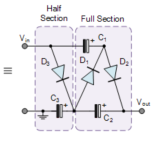Greeting all, I'm having trouble planning a circuit with a 0-135v secondary 230ma into a voltage tippler and a tube rectifier. I have never used a doubler or a tippler before
and am a little confused how to wire this up with the tube rectifier. Thanks in advance for your help!
and am a little confused how to wire this up with the tube rectifier. Thanks in advance for your help!
You will need three diodes with isolated heater windings (three GZ34 wired as a single diode or better etc) and follow this simple circuit.
Edit; suggested rectifier added
Edit; suggested rectifier added
Attachments
Last edited:
You should give a bit more info if you expect a response. What do you mean by 'a little confused'?
Schematic of your doubler/tripler (not tippler) and how you intend to do it?
Or do you need help with the basics of a doubler? Or with the specifics of a tube rectifier after a doubler/tripler and its heater wiring?
Note that a doubler or tripler delivers a DC voltage with ripple, just as a regular rectifier, so you should not need the tube rectifier.
A drawing is worth 1000 words.
Jan
Schematic of your doubler/tripler (not tippler) and how you intend to do it?
Or do you need help with the basics of a doubler? Or with the specifics of a tube rectifier after a doubler/tripler and its heater wiring?
Note that a doubler or tripler delivers a DC voltage with ripple, just as a regular rectifier, so you should not need the tube rectifier.
A drawing is worth 1000 words.
Jan
Last edited:
Odd-numbered voltage multipliers are the worst for ripple, so a tripler is not good, for all that they were used in colour televisions for the EHT. Also, multipliers are for very low currents only; you do not get something for nothing. They produce a lot of ripple and they have a much higher output resistance than more conventional rectification, so their output voltage collapses when you put a load on them. If that sounds as though I'm trying to put you off, it's because I am. Voltage multipliers make sense when you need kV or when you have negligible current draw (like the polarising voltage on an electrostatic loudspeaker).
Voltage multiplayer is a bad idea for audio, especially with rectifier tubes. He should get a suitable transformer and forget about such ideas.
I think one of the famous Marantz amps used a doubler. Anything above doubling is just silly unless it's for a circuit with insignificant current draw.
I think it is a bit of a generalisation to say that a doubler was rarely used, pointing to one implementation. I think they are quite common, and mostly because high voltage electrolytics are hard to come by, especially those able to handle start up voltages where the output tubes need the HT and take a while to warm up.
Tube full wave rectifiers, with multiple heater windings, were also not uncommon in anything commercial where high currents were needed.
I think it could be a 'serious option', depending on the purpose, which was left a bit vague by the OP.
Tube full wave rectifiers, with multiple heater windings, were also not uncommon in anything commercial where high currents were needed.
I think it could be a 'serious option', depending on the purpose, which was left a bit vague by the OP.
- Home
- Amplifiers
- Tubes / Valves
- Voltage tripler and a tube rectifier
